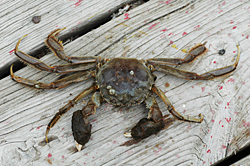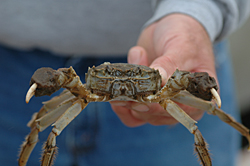
Q. What can you tell us about the Chinese mitten crab?
A. The Chinese mitten crab (Eriocheir sinensis) is a medium-sized crab from temperate and tropical regions of eastern Asia that has been introduced to northern Europe and to the San Francisco Bay drainage on the West Coast of the U.S. This crab is unique in that the juvenile and adult stages live in fresh water and in moist areas adjacent to fresh water. However, the larval stages require salt (or at least brackish) water.
Adults make mass migrations from freshwater to estuarine habitat in order to spawn in salty water. These migrations can involve millions of individuals that leave the water to avoid obstacles and literally cover the landscape as they move seaward toward the estuary.
Q. Is this crab dangerous?
A. This crab is not dangerous, per se. In fact, it is eaten in Asia. Most importantly, the crab is considered a serious pest in areas where it has been introduced.
Q. How did it likely get here?
A. This crab is native to the fresh and brackish waters of eastern Asia. There are at least three ways in which the crab may have arrived here in Delaware Bay: (1) transported in the ballast water of ships arriving here from Asia; (2) importation for sale in specialty food markets; and (3) importation for the freshwater aquarium trade. Thus it may have arrived here accidentally; or it may have been transported here and escaped; or it may have been intentionally released.
Q. Where has it taken up residence in Delaware?
A. So far, the crab has been restricted to the upper reaches of Delaware Bay, that is, the waters adjacent to New Castle and northern Kent counties. Any reports of its occurrence are especially valuable since it is unknown how many waterways it now occupies or whether it has established reproducing populations anywhere in the region.
Q. What are this crab's most distinguishing characteristics? Does it look like our blue crab or other native crab species?
A. The Chinese mitten crab is light brown to olive green. Its carapace is roundish, rather than ellipsoid like a blue crab. The mitten crab does not have paddles like a blue crab does, so the mitten crab cannot swim. The claws are equal in size, have white tips, and have patches of hair. If you catch a crab without obvious hair on its claws, it ain't a mitten crab! This is the only freshwater crab found in North America.
Q. What is its average size?
A. Carapace width in adult crabs is about 4 inches ... considerably smaller than adult blue crabs but larger than many of our native crab species.
Q. What does it eat?
A. Like most crabs, this species is an omnivore. Its prey includes mollusks (clams and snails), sea worms, small crustaceans, small fish and occasional plant material.
Q. How many crab species live in Delaware waters? How many are native, which are invasive? How many of these have you studied?

Q. Does the Chinese mitten crab pose any threats to our native crab, our commercial crabbing industry or recreational crabbing?
A. The Chinese mitten crabs pose some threat as a competitor with blue crabs in areas where their ranges overlap. Beyond that, it is a pretty open question as to what native species will be important competitors or prey items for the mitten crabs. But their main threat lies elsewhere, in their effects on our estuarine and stream habitats: these crabs are industrious burrowers. The major effects of bioinvasive populations in Europe and on the West Coast of the U.S. have been destabilization of stream banks. The species has serious economic and ecological impacts in these regions.
Q. What should people do if they see a Chinese mitten crab in Delaware?
A. People should report the sighting to the Mitten Crab Network at (443) 482-2222 (click here to see PDF) or to the Delaware Department of Natural Resources and Environmental Control's Division of Fish and Wildlife, Fisheries Section, at (302) 739-9914 or (302) 653-2887. They should not return the crab to the water in which it was caught. It is most useful if the specimen is photographed close-up or frozen in a plastic bag so that the identification can be confirmed. It is also very helpful to know when and where the crabs were found and some idea how many specimens were seen.
Article by Tracey Bryant



